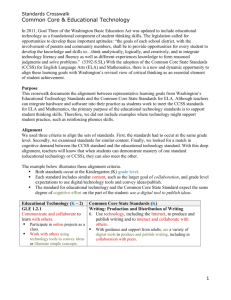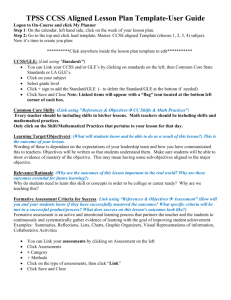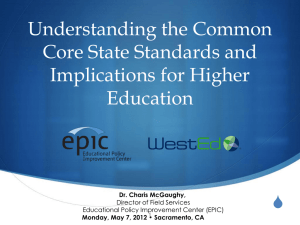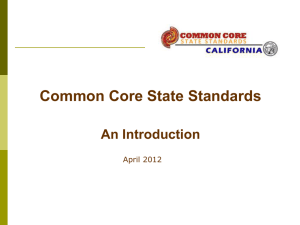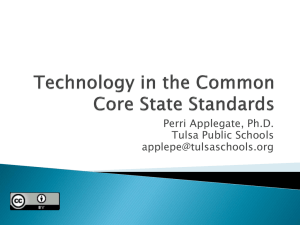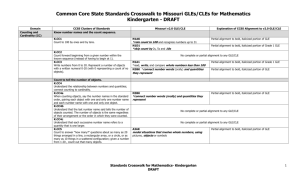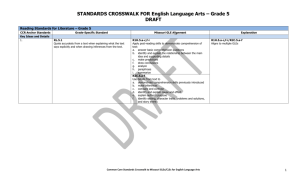Standards Cross Walk Common Core & Educational Technology
advertisement
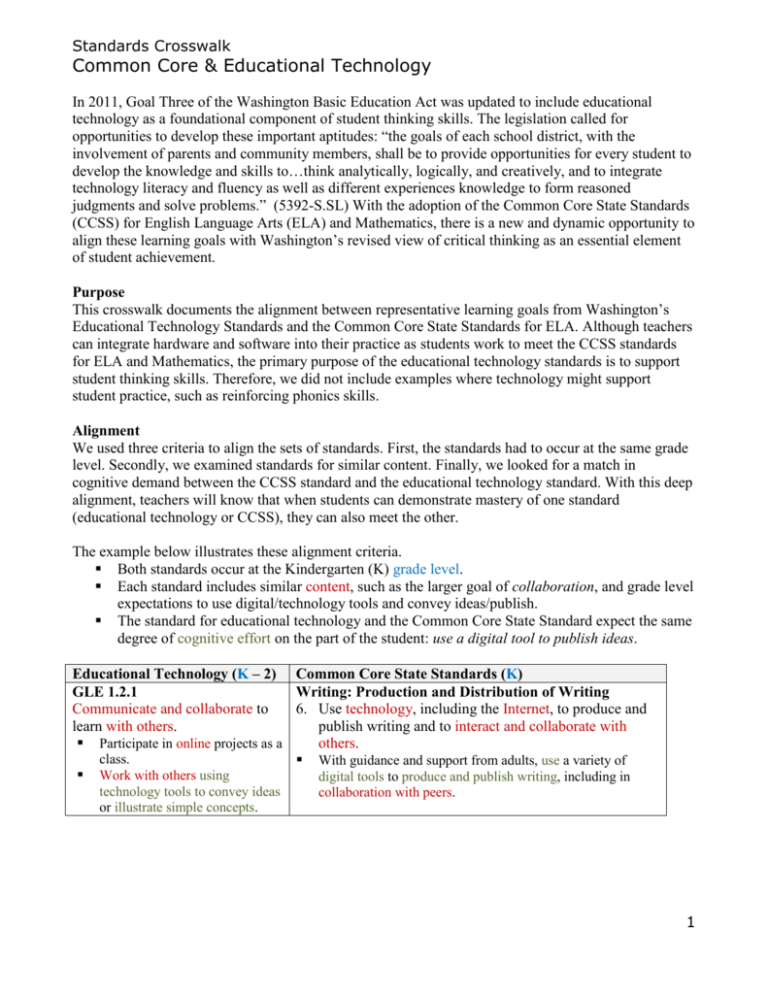
Standards Crosswalk Common Core & Educational Technology In 2011, Goal Three of the Washington Basic Education Act was updated to include educational technology as a foundational component of student thinking skills. The legislation called for opportunities to develop these important aptitudes: “the goals of each school district, with the involvement of parents and community members, shall be to provide opportunities for every student to develop the knowledge and skills to…think analytically, logically, and creatively, and to integrate technology literacy and fluency as well as different experiences knowledge to form reasoned judgments and solve problems.” (5392-S.SL) With the adoption of the Common Core State Standards (CCSS) for English Language Arts (ELA) and Mathematics, there is a new and dynamic opportunity to align these learning goals with Washington’s revised view of critical thinking as an essential element of student achievement. Purpose This crosswalk documents the alignment between representative learning goals from Washington’s Educational Technology Standards and the Common Core State Standards for ELA. Although teachers can integrate hardware and software into their practice as students work to meet the CCSS standards for ELA and Mathematics, the primary purpose of the educational technology standards is to support student thinking skills. Therefore, we did not include examples where technology might support student practice, such as reinforcing phonics skills. Alignment We used three criteria to align the sets of standards. First, the standards had to occur at the same grade level. Secondly, we examined standards for similar content. Finally, we looked for a match in cognitive demand between the CCSS standard and the educational technology standard. With this deep alignment, teachers will know that when students can demonstrate mastery of one standard (educational technology or CCSS), they can also meet the other. The example below illustrates these alignment criteria. Both standards occur at the Kindergarten (K) grade level. Each standard includes similar content, such as the larger goal of collaboration, and grade level expectations to use digital/technology tools and convey ideas/publish. The standard for educational technology and the Common Core State Standard expect the same degree of cognitive effort on the part of the student: use a digital tool to publish ideas. Educational Technology (K – 2) Common Core State Standards (K) GLE 1.2.1 Writing: Production and Distribution of Writing Communicate and collaborate to 6. Use technology, including the Internet, to produce and learn with others. publish writing and to interact and collaborate with Participate in online projects as a others. class. With guidance and support from adults, use a variety of Work with others using digital tools to produce and publish writing, including in technology tools to convey ideas or illustrate simple concepts. collaboration with peers. 1 Standards Crosswalk Common Core & Educational Technology Organization The standards are grouped by grade span (K – 2, 3 – 5, 6 – 8, and 9 – 12) and then arranged in a table. Washington Educational Technology standards appear on the left and list both the Grade Level Expectation (GLE) and the relevant Evidences of Learning. On the righthand side of the table are the Common Core State Standards, including the Career and College Readiness Anchor Standards, and the individual learning standards listed by grade and content area. Adapt & Align This crosswalk represents one of many ways districts can look for connections between standards for educational technology and the CCSS. Based on instructional materials, district-developed assessments, and accessibility to technology, individual districts might need to adapt this crosswalk to support ongoing work. Note: alignment with the CCSS occurs in only seven (out of 15) of the educational technology standards and, in the Common Core ELA, we can align only 10 (out of 36 for K-5, 30 for 6-12) to the state’s educational technology standards. Clearly, one set of standards is not a replacement for the other. Districts should provide opportunities for students to meet the standards in all areas of educational technology. If you have questions or feedback about this document, please contact edtechcba@k12.wa.us or call 360.725.4468. 2 Standards Crosswalk Common Core & Educational Technology: Grade 9 – Grade 12 WA Educational Technology Standards GLE 1.2.1 Communicate and collaborate to learn with others. Common Core State Standards Writing: Production and Distribution of Writing 6. Use technology, including the Internet, to produce and publish writing and to interact and collaborate with others. Speaking and Listening: Presentation of Knowledge and Ideas 5. Make strategic use of digital media and visual displays of data to express information and enhance understanding of presentations. Interact and collaborate with others using a variety of digital tools. Communicate information and ideas effectively to multiple audiences using a variety of media and formats. W.9.6 & W.10.6 W.11.6 & W.12.6 SL.9.5, SL 10.5, SL 11.5, & SL 12.5 Use technology, including the Internet, to produce, publish, and update individual or shared writing products, taking advantage of technology’s capacity to link to other information and to display information flexibly and dynamically. Use technology, including the Internet, to produce, publish, and update individual or shared writing products in response to ongoing feedback, including new arguments or information. Make strategic use of digital media (e.g., textual, graphical, audio, visual, and interactive elements) in presentations to enhance understanding of findings, reasoning, and evidence and to add interest. GLE 1.3.1 Identify and define authentic problems and significant questions for investigation and plan strategies to guide inquiry. Writing: Research to Build and Present Knowledge 7. Conduct short as well as more sustained research projects based on focused questions, demonstrating understanding of the subject under investigation. W.9.7, W.10.7, W.11.7 & W.12.7 Explore possible topics and available information on current issues using databases and digital resources to organize a project or solve a problem. Conduct short as well as more sustained research projects to answer a question (including a self-generated question) or solve a problem; narrow or broaden the inquiry when appropriate; synthesize multiple sources on the subject, demonstrating understanding of the subject under investigation. 3 Standards Crosswalk Common Core & Educational Technology: Grade 9 – Grade 12 WA Educational Technology Standards GLE 1.3.3 Analyze, synthesize, and ethically use information to develop a solution, make informed decisions, and report results. Common Core State Standards Writing: Text Types and Purposes 1. Write arguments to support claims in an analysis of substantive topics or texts using valid reasoning and relevant and sufficient evidence. Writing: Research to Build and Present Knowledge 8. Gather relevant information from multiple print and digital sources, assess the credibility and accuracy of each source, and integrate the information while avoiding plagiarism. Combine information from separate sources to produce, support, and counter arguments. Assess the credibility, validity, and potential bias of online resources. Apply copyright law to correctly excerpt, paraphrase, and publish results to a wider audience. Cite sources using bibliography tools. Select relevant sources for a particular purpose or audience. W.9.1, W.10.1, W.11.1 & W.12.1 Write arguments to support claims in an analysis of substantive topics or texts, using valid reasoning and relevant and sufficient evidence. W.9.8 & W.10.8 Gather relevant information from multiple authoritative print and digital sources, using advanced searches effectively; assess the usefulness of each source in answering the research question; integrate information into the text selectively to maintain the flow of ideas, avoiding plagiarism and following a standard format for citation. Gather relevant information from multiple authoritative print and digital sources, using advanced searches effectively; assess the strengths and limitations of each source in terms of the task, purpose, and audience; integrate information into the text selectively to maintain the flow of ideas, avoiding plagiarism and overreliance on any one source and following a standard format for citation. W.11.8 & W.12.8 GLE 1.3.4 Use multiple processes and diverse perspectives to explore alternative solutions. Explore and integrate alternative concepts and feedback from multiple audiences. Develop a range of problem-solving skills. Writing: Production and Distribution of Writing 5. Develop and strengthen writing as needed by planning, revising, editing, rewriting, or trying a new approach. W.9.5, W.10.5, W.11.5 & W.12.5 Develop and strengthen writing as needed by planning, revising, editing, rewriting, or trying a new approach, focusing on addressing what is most significant for a specific purpose and audience. 4
